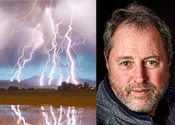Lightning reaches 50,000 degrees Fahrenheit, fours times as hot as the sun”s surface.
Astraphobia is the fear of thunder and lightning.
Lightning is an atmospheric electrostatic discharge.
Lightning can—and often does—strike in the same place twice. Tall buildings and monuments are frequently hit by lightning.
An umbrella can increase your chances of being struck by lightning if it makes you the tallest object in the area.
Cloud-to-cloud lightning- Multiple paths of cloud-to-cloud lightning, Lightning discharges may occur between areas of cloud without contacting the ground. When it occurs between two separate clouds it is known as inter-cloud lightning and when it occurs between areas of differing electric potential within a single cloud, it is known as intra-cloud lightning. Intra-cloud lightning is the most frequently occurring type.
There are approximately 100,000 thunderstorms in the U.S. each year.
A cloud-to-ground lightning channel can be 2 to 10 miles long.
Voltage in a cloud-to-ground strike is 100 million to 1 billion volts.
The study of lightning is known as fulminology.
When lightning strikes the ground it seeks out the shortest route to something with a positive charge, this might be a tree, a tall building or if they’re very unlucky, a person.
Thousands of people are struck by lightning every year.
Direct lightning strikes are usually fatal.
The rapid expansion of heated air causes the thunder. Since light travels faster than sound, the thunder is heard after the lightning. If you see lightning and hear thunder at the same time, that lightning is in your neighborhood. If you see successive strokes of lightning in the same place on the horizon then you are in line with the storm, and it may be moving toward you.
Cumulonimbus, The name for a tall dark thunderstorm cloud comes from a combination of two Latin words, “cumulus,” meaning “heap,” and “nimbus,” which means “rainstorm.”
Cloud-to-cloud lightning- Multiple paths of cloud-to-cloud lightning, Lightning discharges may occur between areas of cloud without contacting the ground. When it occurs between two separate clouds it is known as inter-cloud lightning and when it occurs between areas of differing electric potential within a single cloud, it is known as intra-cloud lightning. Intra-cloud lightning is the most frequently occurring type.[14]
These are most common between the upper anvil portion and lower reaches of a given thunderstorm. This lightning can sometimes be observed at great distances at night as so-called “heat lightning”. In such instances, the observer may see only a flash of light without hearing any thunder. The “heat” portion of the term is a folk association between locally experienced warmth and the distant lightning flashes.
Another terminology used for cloud-cloud or cloud-cloud-ground lightning is “Anvil Crawler”, due to the habit of the charge typically originating from beneath or within the anvil and scrambling through the upper cloud layers of a thunderstorm, normally generating multiple branch strokes which are dramatic to witness.
Most lightning strikes average 2 to 3 miles long and carry a current of 10000 Amps at 100 million Volts.
Rubber shoes will not give you any meaningful protection from lightning.
Lightning is one of the leading weather-related causes of death and injury in the United States. Most people do not realize that they can be struck by lightning even when the center of a thunderstorm is 10 miles (16 kilometers) away and there are blue skies overhead.
When the sun is low in the sky, such as before sunset when most severe storms occur, the reddening light of the sun when shining through Earth’s atmosphere makes the bluish cloud tint turn green.
Lightning can occur with either positive or negative polarity; negative is more common, but positive lightning can carry ten times more current. In either case, the amount of voltage depends on the length of the bolt – the longer the bolt, the higher the voltage. Lightning can heat the surrounding air to thousands of degrees. This causes the air to expand rapidly which generates a supersonic shock wave that as it dissipates becomes an acoustic wave we hear as thunder.
One famous lightning hit was the Eiffel Tower in 1902.
Most lightning strikes occur either at the beginning or end of a storm.



